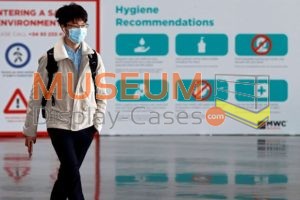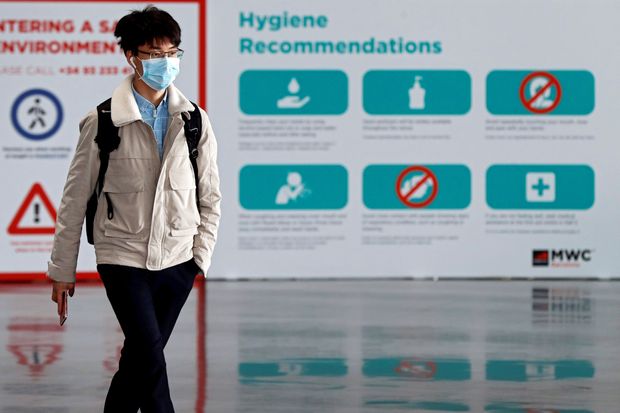 https://www.tsnn.com/blog/trade-show-etiquette-changes-prepare-after-covid19
https://www.tsnn.com/blog/trade-show-etiquette-changes-prepare-after-covid19
Briquelle Neyens is a digital marketer at Skyline Exhibits’ corporate office in St. Paul, Minn. Besides immersing herself in trade show research and the ins and outs of exhibit sales, she also engages with Skyline’s wide-array of products and services from an insider’s perspective. She enjoys generating information to help trade show marketers be successful on the show floor.
Teaching proper trade show etiquette to your booth staff is a must if you want to grab attendees’ attention. Properly greeting, understanding expectations and keeping attendees engaged are all highly important and will impact your exhibiting results.
Since COVID-19 has brought on what’s now globally known as social distancing, the rules of etiquette are already shifting. Here’s how some etiquette expectations may shift moving forward once trade shows are back up and running.
Greeting Attendees
It’s important for your booth staff to stand and greet attendees warmly at the front of your booth. Pre-COVID-19, we would have recommended creating an area at the entrance of your booth that doesn’t feel like a barrier for passing attendees. However, people may now feel more comfortable feeling like they have control over the distance they keep from others.
Rather than having a wide-open entrance, a better option may be to put your staff at or near a small entrance counter. This way, they still seem approachable, but not so “in your face” to passing attendees. A great option for a streamline counter is one that can be used as a workstation, demo station or product display stand. You’ll also be able to incorporate your graphics, which is a great way to stand out as people pass through aisles and aisles of booths.
It will be important for your booth staff to stay behind the counter and let the attendee be the judge of if they’d like to step inside your booth, rather than feeling uncomfortably coaxed in.
A great form of etiquette to teach your booth staff when greeting visitors is to ask an open-ended question instead of a yes or no question. This makes it easier to start a conversation, rather than an attendee answering “no” and moving right along. Or, your staff could opt for something like, ‘Let me show you XYZ about our company.” Once again, this gets the conversation moving quicker than yes or no answers and also draws attention much sooner.
Attendee Engagement
You want your booth staff to be well trained so they’re able to keep attendees in your booth. With COVID-19 making it difficult to get too personal with attendees, make sure your staff knows how to be engaging, without being overly engaging.
To start, avoiding unnecessary contact, such as handshakes, may just become the new norm. Shaking hands will be a hard habit to break, but one route for your booth staff to go is to let booth guests guide this interaction. If they don’t reach out for a handshake, leave it at that and know that both sides are in agreement and understanding of the situation. A tilt of the head could be a simple replacement.
However, if an attendee does reach out for a handshake, it could feel rude to resist, making things awkward from that moment on. Rather than ignoring their handshake or awkwardly trying to explain why you’d rather not shake their hand, simply move forward with the handshake. Remember to keep hand sanitizer on standby for instances when you do come in contact with attendees. A great way to show that you care about your booth guests will be making hand sanitizer accessible throughout your exhibit.
Another important trade show etiquette tip is to teach your staff to be professional, approachable, helpful, proactive and enthusiastic. It’s important that they’re knowledgeable on your company and its products and services so that they’re able to answer any questions that come up. You also want to feel confident that they’re able to represent your organization in the most positive light. Making sure all of these bases are hit will ensure that your staff is able to be engaging and useful to prospects.
Proper etiquette for engaging and friendly body language includes smiling and making eye contact, not crossing arms, keeping hands out of pockets, not leaning against booth walls or furniture, avoiding sitting down unless sitting with a client who wants to sit and giving full attention to attendees rather than chatting with colleagues.
Minding Attendees’ Space
A new form of etiquette that will likely be far more relevant post-COVID-19 trade shows is being careful not to overstep boundaries. Giving others enough space to feel comfortable will be an important aspect of exhibiting for everyone on the show floor.
Something you might want to incorporate in your exhibit to ensure that people don’t feel crowded is designated standing areas. You may have seen markings at your checkout area in your local grocery stores to keep shoppers in each aisle at a respective distance during the COVID-19 pandemic. This idea could be similarly used in your booth to ensure that it doesn’t feel overcrowded.
Also ensure that your booth space is large enough. Paying attention to previous shows is a pretty good indicator of whether or not your booth has felt a little crowded in the past. If you’ve continued to grow as a business since your last trade show, consider a larger booth space that allows for more traffic and more quality interactions with prospects.
To keep people from gathering in one small area, make your exhibit easy to navigate. This will lead to good traffic flow and engagement. You won’t have to worry about people being congregated in one area because that’s the “best seat in the house.” There are a lot of ways to guide attendees seamlessly through your booth without them feeling like the space is too tight.
There will be plenty of changes to look out for once COVID-19 passes and trade shows are back in action. With these changes impacting trade show etiquette especially, be sure that your booth staff is up to date on the latest social expectations. Also, consider your booth space and how it plays a role in allowing people to feel at a safe distance from one another.

